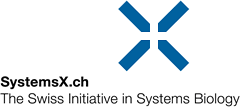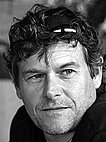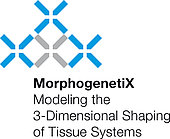MorphogenetiX
Modelling the 3-Dimensional Shaping of Tissue Systems
The overall shape of an organism is laid down during embryonic development. Thereafter, tissue shaping is needed mainly during wound healing or when tissues adapt to mechanical stress or infection. How tissues deform in a controlled way to reliably generate a defined shape is a fundamental open question in biology. It also has medical relevance in the light of a central goal of stem cell research and the growth of replacement organs outside the body.
Tissue shaping requires the orchestrated generation of mechanical forces by individual cells in cell collectives. Until recently, this was believed to be entirely controlled by the differentiation state of cells, which is in turn determined by signalling networks activating specific genetic programs. However, tissue shaping turns out to be a dynamic feedback process in which cells generate forces in response to their differentiation state, but also differentiate into different cell types in response to differences in the forces they sense.
Forces in living tissues and cells
Such complexity calls for a systems biology approach that integrates the mechanical forces of tissue morphogenesis into the molecular programs of differentiation. The study of forces in living tissues and cells is a challenge, which is why modelling emerged as a powerful explorative tool. Simplified, 2-dimensional models simulating very specific aspects of a tissue system and considering cells as identical building blocks have been used up to now. However, tissues deform and grow in three dimensions, and cell-to-cell variability is a fundamental aspect of biological systems.
Comprehensive models include the third dimension
“MorphogenetiX” is designed as an interdisciplinary effort, integrating these properties into the study of tissue shaping. Large-scale, quantitative analysis of live imaging data, covering various properties of individual type and mutant cells and of tissues in space and over time, will set the basis for the generation of comprehensive models of tissue shaping. These will explicitly include the third dimension as well as cell-to-cell variability. The predictive power of these models will trigger new experiments that will feed back into the models. The goal is to identify generic processes that are relevant to the morphogenesis of all tissues. Our study will also include the generation of novel tools to monitor and manipulate forces in vivo and a proteomics-based screen to identify critical molecular factors.
| Principal Investigator | Prof. Damian Brunner, Institute of Molecular Life Sciences, University of Zurich |
| Involved Institutions | University of Zurich, University of Basel, Max Planck Institute Köln |
| Number of Research Groups | 5 |
| Project Duration | Mar. 2014 – Feb. 2018 |
| Approved SystemsX.ch Funds | CHF 2.993 million |
Updated June 2014


